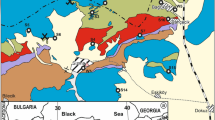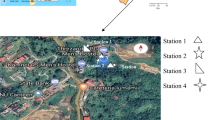Abstract
Monitoring and assessment of surface drinking water resources is vital for human life. As it is known, many diseases are caused by contaminated waters. Surface water resources quality was classified in terms of treatment potential by using 41 conventional parameters in Turkey. It is not insufficient to take these conventional parameters into account alone due to the fact that there exist new developments in application of varying level of different chemicals generated as part of daily activities. The main objective of this study is to recommend some changes for the water resources quality classification of Turkey by investigating the No Observed Adverse Effect Limit (NOAEL) and Lowest Observed Adverse Effect Level (LOAEL) classifications of different pollutants. These pollutants are associated with highest and lowest doses at which there was not an observed toxic or adverse effect, respectively. This new evaluation scheme will allow integration of new pollutants, i.e., micropollutants, and monitoring as per the findings of this study. A detailed site-specific monitoring was also undertaken by collecting samples from 283 of surface water locations at four times during the year across Turkey. The results obtained in this study indicate that, even if there is a pressure in terms of micropollutants in surface water resources of Turkey, the problem in terms of conventional parameters are more dominated and the water quality problems in Turkey have been exacerbated in terms of microbiological indicators such as total coliform, fecal coliform and fecal streptococcus. It is also important to note that the heavy metal concentrations originated from the site-specific geological formation were detected in the surface drinking water resources of Turkey.

Similar content being viewed by others
REFERENCES
World Health Organization. https://www.who.int/news-room/fact-sheets/detail/drinking-water. Accessed October 10, 2019.
Li, P. and Wu, J., Drinking water quality and public health, Exposure Health, 2019, vol. 11, pp. 73–79. https://doi.org/10.1007/s12403-019-00299-8
Koklu, R., Sengorur, B., and Topal, B., Water quality assessment using multivariate statistical methods-a case study: Melen River system (Turkey), Water Resour. Manage., 2010, vol. 24, pp. 959–978. https://doi.org/10.1007/s11269-009-9481-7
Schwarzenbach, R.P., Egli, T., Hofstetter, T.B., Gunten, U., and Wehrli, B., Global water pollution and human health, Annu. Rev. Environ. Resour., 2010, vol. 35, pp. 109–136.
Benner, J., Helbling, D.E., Kohler, H.P., Wittebol, J., Kaiser, E., Prasse, C., Ternes, A.T., Albers, C.N., Aamand, J., Horemans, B., Springael, D., Walravens, E., and Boon, N., Is biological treatment a viable alternative for micropollutant removal in drinking water treatment processes? Water Res., 2013, vol. 47, no. 16, pp. 5955–5976.
Delpla, I., Jung, A.V., Baures, E., Clement, M., and Thomas, O., Impacts of climate change on surface water quality in relation to drinking water production, Environ. Int., 2009, vol. 35, no. 8, pp. 1225–1233.
Petrovic, M., Gonzales, S., and Barcelo, D., Analysis and removal of emerging contaminants in wastewater and drinking water, TrAC, Trends Anal. Chem., 2003, vol. 22, no. 10, pp. 685–696.
Council Directive 80/778/EC of July15, Relating to the quality of water intended for human consumption, Off. J. Eur. Commun., 1980, vol. L229, pp. 11–29.
Council Directive 98/83/EC of November 3, On the quality of water intended for human consumption, Off. J. Eur. Commun., 1998, vol. L330, pp. 32–54.
Dolan, T., Howsam, P., Parsons, D.J., and Whelan, M.J., Is the EU Drinking Water Directive Standards for pesticides in drinking water consistent with the precautionary principle? Environ. Sci. Technol., 2013, vol. 47, pp. 4999–5006.
Richardson, S.D., Environmental mass spectrometry: Emerging contaminants and current issues, Anal. Chem., 2012, vol. 84, no. 2, pp. 747–778.
Stuart, M., Lapwort, D., Crane, E., and Hart, A., Review of risk from potential emerging contaminants in UK groundwater, Sci. Total Environ., 2012, vol. 416, pp. 1–21.
Richardson, S.D. and Ternes, T.A., Water analysis: Emerging contaminants and current issues, Anal. Chem., 2014, vol. 86, no. 6, pp. 2813–2848.
Benotti, M.J., Trenholm, R.A., Vanderford, B.J., Holady, J.C., Stanford, B.D., and Snyder, S.A., Pharmaceuticals and endocrine disrupting compounds in U.S. drinking water, Environ. Sci. Technol., 2009, vol. 43, no. 3, pp. 597–603.
Geissen, V., Mol, H., Klumpp, E., Umlauf, G., Nadal, M., van der Ploeg, M., ven de Zee, S.E.A.T.M., and Ritsema, C., Emerging pollutants in the environment: A challenge for water resource management, Int. Soil Water Conserv. Res., 2015, vol. 3, no. 1, pp. 57–65.
Ruff, M., Mueller, M.S., Loos, M., and Singer, H.P., Quantitative target and systematic non-target analysis of polar organic micro-pollutants along the River Rhine using high-resolution mass-spectrometry-Identification of unknown sources and compounds, Water Res., 2015, vol. 87, pp. 145–154.
Schwarzenbach, R.P., Escher, B.I., Fenner, K., Hofstetter, T.B., Johnson, C.A., von Gunten, U., and Wehrli, B., The challenge of micropollutants in aquatic systems, Science, 2006, vol. 313, no. 5790, pp. 1072–1077.
Stackelberg, P.E., Gibs, J., Furlong, E.T., Meyer, M.T., Zaugg, S.D., and Lippincott, R.L., Efficiency of conventional drinking-water-treatment processes in removal of pharmaceuticals and other organic compounds, Sci. Total Environ., 2007, vol. 377, nos. 2–3, pp. 255–272.
Badach, H., Nazimek, T., and Kaminska, I.A., Pesticide content in drinking water samples collected from orchard areas in Central Poland, Ann. Agric. Environ. Med., 2007, vol. 14, no. 1, pp. 109–114.
Mekonen, S., Argaw, R., Simanesew, A., Houbraken, M., Senaeve, D., Ambelu, A., and Spanoghe, P., Pesticide residues in drinking water and associated risk to consumers in Ethiopia, Chemosphere, 2016, vol. 162, pp. 252–260.
Margot, J., Kienle, C., Magnet, A., Weil, M., Rossi, L., De Alencastro, L.F., Abegglen, C., Thonney, D., Chèvre, N., Schärer, M., and Barry, D.A., Treatment of micropollutants in municipal wastewater: Ozone or powdered activated carbon? Sci. Total Environ., 2013, vols. 461–462, pp. 480–498.
Ternes, T.A., Meisenheimer, M., McDowell, D., Sacher, F., Brauch, H.J., Haist-Gulde, B., Preuss, G., Wilme, U., and Zulei-Seibert, N., Removal of pharmaceuticals during drinking water treatment, Environ. Sci. Technol., 2002, vol. 36, no. 17, pp. 3855–3863.
By-law on quality of surface water to be obtained or planned to be obtained as drinking water, Off. Gaz. Turk. Rep., 2012, no. 28338, June 29. http://www.resmigazete.gov.tr/eskiler/2012/06/20120629-9.htm. Accessed September 10, 2018.
Baltacı, F., Onur, A.K., and Tahmiscioǧlu, S., Water quality monitoring studies of Turkey with present and probable future constraints and opportunities, Desalination, 2008, vol. 226, nos. 1–3, pp. 321–327. https://doi.org/10.1016/j.desal.2007.02.114
Final Report of Technical Assistance for Assessment of Drinking Water Resources and Treatment Plants in Turkey: Service Contract No. 2007TR16IPO001.3.02/SER/32, Ankara: Gen. Dir. Eur. Union Foreign Relat., 2017.
By-law on water intended for human consumption, Off. Gaz. Turk. Rep., 2005, no. 25730, Feb. 17. https://www.resmigazete.gov.tr/eskiler/2005/02/20050217-3.htm. Accessed September 10, 2019.
Munro, I.C., Carlo, G.L., Orr, J.C., Sund, K.G., Wilson, R.M., Kennepohl, E., Lynch, B.S., and Jablinske, M.A., Comprehensive, integrated review and evaluation of the scientific evidence relating to the safety of the herbicide 2.4-D, Int. J. Toxicol., 1992, vol. 11, no. 5, pp. 559–664.
Silva, M.H. and Carr, W.C., Jr., Human health risk assessment of endosulfan: II. Dietary exposure assessment, Regul. Toxicol. Pharmacol., 2010, vol. 56, no. 1, pp. 18–27.
Carpy, S.A., Kobel, W., and Doe, J., Health risk of low-dose pesticides mixtures: A review of the 1985–1998 literature on combination toxicology and health risk assessment, J. Toxicol. Environ. Health, Part B, 2000, vol. 3, no. 1, pp. 1–25.
Lyndy, M., Belden, J., Wheelock, C., Hammock, B., and Denton, D., Challenges in regulating pesticide mixtures, Ecol. Soc., 2004, vol. 9, no. 6, p. 1.
Haber, L.T., Dourson, M.L., Bruce, C., Allen, B.C., Hertzberg, R.C., Parker, A., Vincent, M.J., Maier, A., and Boobis, A.R., Benchmark dose (BMD) modeling: Current practice, issues, and challenges, Crit. Rev. Toxicol., 2018, vol. 48, no. 5, pp. 387–415. https://doi.org/10.1080/10408444.2018.1430121
ACKNOWLEDGMENTS
This paper was built on a European Union funded Project of TADWRTP – Technical Assistance for Assessment of Drinking Water Resources and Treatment Plants in Turkey, Service Contract no. 2007TR16IPO001.3.02/ SER/32—that was conducted across Turkey. The source of data used in this study were collected and produced in this project. The author would like to thank experts and managers of the Ministry of Agriculture and Forestry–General Directorate of Water Management of Turkey as the beneficiary of the TADWRTP Project. Special thanks go to the European Union for providing co-financing of the project. It is important to note that the results and conclusions presented in this paper reflect only the author’s view and that the General Directorate of Water Management of Turkey, and that the European Union are not liable for any use that may be made of the information contained therein.
Author information
Authors and Affiliations
Corresponding author
About this article
Cite this article
Bülent Selek Assessment of Surface Drinking Water Resources of Turkey in Terms of Water Quality Standards. J. Water Chem. Technol. 42, 415–426 (2020). https://doi.org/10.3103/S1063455X20050124
Received:
Revised:
Accepted:
Published:
Issue Date:
DOI: https://doi.org/10.3103/S1063455X20050124




